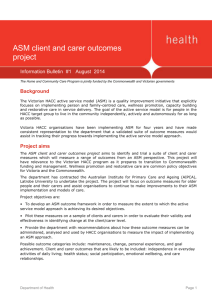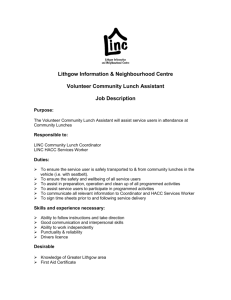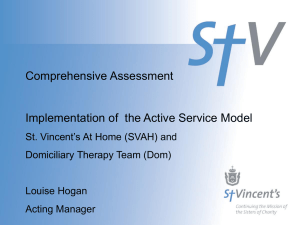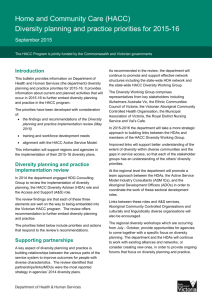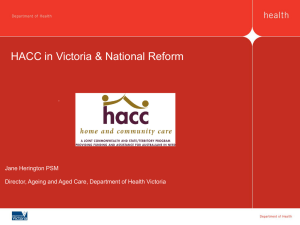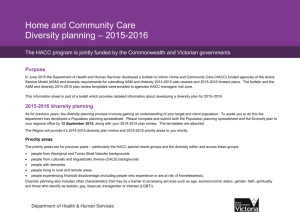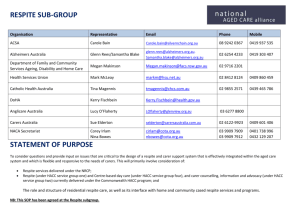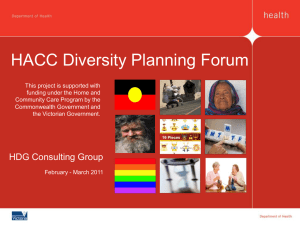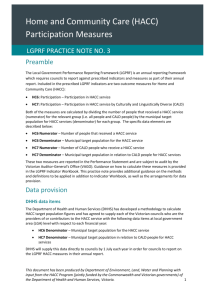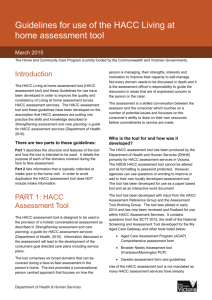ASM Planning Resources 2015
advertisement
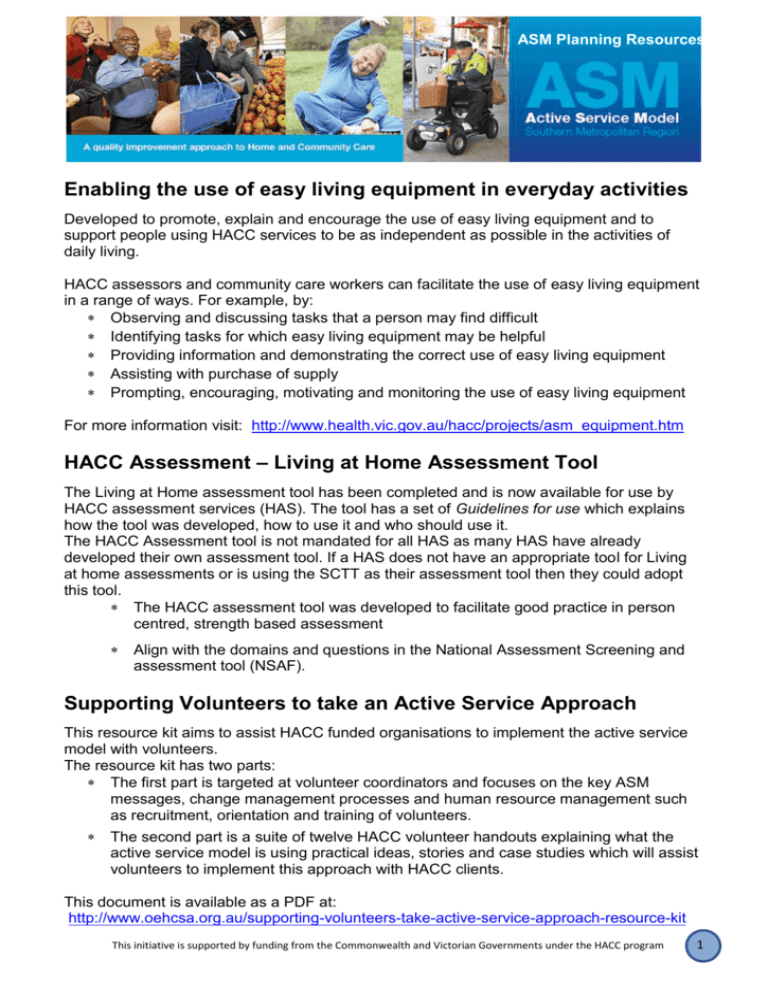
ASM Planning Resources. Enabling the use of easy living equipment in everyday activities Developed to promote, explain and encourage the use of easy living equipment and to support people using HACC services to be as independent as possible in the activities of daily living. HACC assessors and community care workers can facilitate the use of easy living equipment in a range of ways. For example, by: Observing and discussing tasks that a person may find difficult Identifying tasks for which easy living equipment may be helpful Providing information and demonstrating the correct use of easy living equipment Assisting with purchase of supply Prompting, encouraging, motivating and monitoring the use of easy living equipment For more information visit: http://www.health.vic.gov.au/hacc/projects/asm_equipment.htm HACC Assessment – Living at Home Assessment Tool The Living at Home assessment tool has been completed and is now available for use by HACC assessment services (HAS). The tool has a set of Guidelines for use which explains how the tool was developed, how to use it and who should use it. The HACC Assessment tool is not mandated for all HAS as many HAS have already developed their own assessment tool. If a HAS does not have an appropriate tool for Living at home assessments or is using the SCTT as their assessment tool then they could adopt this tool. The HACC assessment tool was developed to facilitate good practice in person centred, strength based assessment Align with the domains and questions in the National Assessment Screening and assessment tool (NSAF). Supporting Volunteers to take an Active Service Approach This resource kit aims to assist HACC funded organisations to implement the active service model with volunteers. The resource kit has two parts: The first part is targeted at volunteer coordinators and focuses on the key ASM messages, change management processes and human resource management such as recruitment, orientation and training of volunteers. The second part is a suite of twelve HACC volunteer handouts explaining what the active service model is using practical ideas, stories and case studies which will assist volunteers to implement this approach with HACC clients. This document is available as a PDF at: http://www.oehcsa.org.au/supporting-volunteers-take-active-service-approach-resource-kit This initiative is supported by funding from the Commonwealth and Victorian Governments under the HACC program 1 ASM Planning Resources. Active in the South – An eLearning resource ASM Planning The Active Service in the South resource has been released. This resource canResources. be used for inducting staff who are new to Home and Community Care (HACC) and to consolidate the knowledge and understanding of ASM for existing staff. The resource provides information about the Active Service Model (ASM) using interviews, short video case-studies and reflective questions to demonstrate the ASM principles in practice. A link to the website is http://www.activeserviceinthesouth.org.au/asm-training-package-3-0. Eastern Metro Region (EMR) HACC Alliance Consumer Toolkit A great resource designed to support HACC agencies, originally for the EMR, to develop and implement effective and efficient consumer feedback systems. The project was supported by the EMR HACC Alliance and the toolkit contains practical advice tools and strategies to assist staff to design, plan and implement consumer feedback strategies that are effective, efficient and appropriate for a diverse range of clients. This toolkit is available to download: http://www.iepcp.org.au/eastern-metropolitan-region-%E2%80%93-home-and-communitycare-alliance/tools-and-resources PAG – Dementia Friendly Social Support Environments This document is a checklist summarising best practice ideas to ensure social support programs such as HACC funded Planned Activity Groups (PAGs) are dementia friendly. The purpose of the checklist is to assist all social support programs to compare current arrangements with a broad range of best practice approaches to identify improvements that will support group participants living with dementia, their carers and staff. Developed by Uniting Aged Well Kalkee Community Centre and the Department of Health and Human Services Barwon South Western Region 2 This initiative is supported by funding from the Commonwealth and Victorian Governments under the HACC program ASM Planning Resources. PAG Pathways V2 – A guide to implementing an active service approach to planned activity groups Designed to: assist with the implementation of the active service model principles, to build confidence with ASM and to assist users to look at the different ways of supporting people attending planned activity groups (PAGs). ASM Planning Resources. The guide is designed to be a companion and reference for all staff and volunteers supporting clients who attend PAGs and their carers. http://www.each.com.au/images/_service_files/PAG_PathwaysManual.pdf Developed by Yarra Ranges Council, Caladenia Dementia Care, EACH Social and Community Health Golden Wattle and Department of Health, Home and Community Care. DVD - Purposeful Activities for Dementia This video presentation provides information on a range of Montessori based activities that can add further purpose to social and community interaction. The video can be viewed at: https://vic.fightdementia.org.au/purposeful-activities Activity Cards—Creating Conversations that Support Choice Developed by Bairnsdale Regional Health Service the cards show images of individual and group activities and everyday life events. The images generate conversations and interaction with conversation prompts for staff and carers. Contact Liz Brown, Bairnsdale Regional Health Service Email: elizabeth.brown@brhs.com.au Physical Activity in Planned Activity Groups How much physical activity is appropriate for a PAG? This landmark study addresses this very question and makes recommendations that focus on physical activity, wellness and engagement. The report is available at: http://www.health.vic.gov.au/regions/Gippsland/publications The e-learning tool is at: http://www.nari.inimelb.edu.au/elearning/story.htms Contact Dr Frances Batchelor at the National Ageing Research Institute Email: f.batchelor@nari.unimelb.edu.au This initiative is supported by funding from the Commonwealth and Victorian Governments under the HACC program 3 ASM Planning Resources. Make it meaningful: PAG assessment and care planning guidelines and tools A resource developed for HACC Active Service Model (ASM) Planned Activity Groups (PAGs) in relation to assessment and care planning. The guidelines and associated tools will have a practical, ‘how to’ focus to support active service model practice. They will be applicable to the diverse range of PAGs across Victoria and support achievement of the Community Care Common Standards in relation to PAG assessment and care planning. The practice guidelines and tools will focus on assessment and care planning in PAGs. They will include: practice guidelines with ‘how to’ information PAG assessment tools with instructions for use care planning templates for individual, goal directed care planning in a group setting case studies and examples for different types of organisations and different types of PAGs practical information and tools. Copies of this tool will be distributed to each program over the next few weeks and will be online soon at http://www.health.vic.gov.au/hacc/assessment.htm Living well at home: CHSP Good Practice Guide Commonwealth Home Support Programme (CHSP), Key elements of the creation of the CHSP from 1 July 2015 include the following: • one consolidated program providing entry-level home support; • a standardised national assessment process that will include the development of goal orientated, person-centred support plans for clients; and • an increased focus on ways of working aimed at maximising client independence and autonomy (known in the aged care literature as wellness, reablement and restorative care). A Commonwealth Home Support Programme Manual has been produced to spell out what is required of providers in the delivery and management of the CHSP. The Programme Manual forms part of the grant agreement between a provider and the Department. This Good Practice Guide is intended to complement the Programme Manual and support the take up of wellness approaches in home care services. https://www.dss.gov.au/our-responsibilities/ageing-and-aged-care/aged-carereform/commonwealth-home-support-programme/living-well-at-home-chsp-good-practiceguide 4 This initiative is supported by funding from the Commonwealth and Victorian Governments under the HACC program ASM Planning Resources. Growing with age short videos Watch HACC clients and staff talk about their experiences with the Active Service Model approach to care. The footage was the result of a collaborative project between Bayside City Council, City of Greater Dandenong, City of Kingston, City of Stonington, Frankston City Council, Mecwacare and the Royal District Nursing Service as part of a partnership of agencies working across the Southern Metropolitan Region to implement an Active Service Model approach. The project was supported with funding under the Home and Community Care program by the Commonwealth Government and the Victorian Government. http://www.health.vic.gov.au/hacc/projects/asm_gwa.htm Goal Directed Care Planning Toolkit The toolkit includes a range of practical tools to support staff set goals and develop effective care planning with HACC clients. It also includes information and guidelines to support organisations review their systems that support GDCP and evaluate their practice. Link to this toolkit is http://www.oehcsa.org.au/library-resources/special-projects/active-service-model-asm/asmresources/goal-directed-care-plannin Paula Clancy SMR ASM - Industry Consultant Bayside City Council 76 Royal Avenue Sandringham VIC 3191 P: 9599 4714 M: 0419 186 291 E: pclancy@bayside.vic.gov.au Alison Clarke SMR ASM - Industry Consultant Bayside City Council 76 Royal Avenue Sandringham VIC 3191 P: 9599 4462 M: 0419 376 893 E: aclarke@bayside.vic.gov.au This initiative is supported by funding from the Commonwealth and Victorian Governments under the HACC program 5
